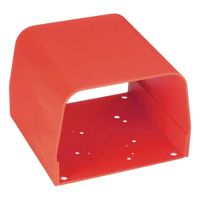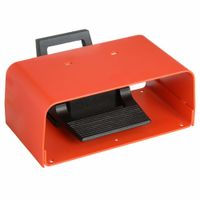Call +(254) 703 030 000 / 751 483 999 / 721 704 777
- Home
- Electrical
- Industrial Controls Automation And Machine Safety
- Machine Safety
- Foot Switches Foot Switch Guards
.....Read More
Frequently Asked Questions
What are the different types of foot switches and their applications?
Foot switches come in various types, each designed for specific applications:
1. **Momentary Foot Switches**: These are activated only while the pedal is pressed. Commonly used in sewing machines, power tools, and medical devices where temporary activation is needed.
2. **Maintained Foot Switches**: These remain in the on or off position after being pressed. They are used in applications like lighting control and machinery where continuous operation is required without constant pressure.
3. **Variable Speed Foot Switches**: These allow the user to control the speed or intensity of the connected device. They are often used in sewing machines and electric guitars for volume control.
4. **Safety Foot Switches**: Designed with a protective cover to prevent accidental activation, these are used in industrial environments where safety is a concern, such as in heavy machinery operations.
5. **Anti-Trip Foot Switches**: These have a design that prevents accidental tripping, suitable for environments where multiple foot switches are used, like in assembly lines.
6. **Wireless Foot Switches**: These eliminate the need for cables, offering flexibility and mobility. They are used in medical and audio-visual applications where cable management is crucial.
7. **Double or Multi-Pedal Foot Switches**: These have multiple pedals for controlling different functions simultaneously. They are used in musical instruments and complex machinery operations.
8. **Heavy-Duty Foot Switches**: Built to withstand harsh environments, these are used in industrial settings where durability is essential.
Each type of foot switch is tailored to meet specific operational needs, enhancing efficiency, safety, and user convenience in various applications.
How do you install a foot switch?
1. **Select the Foot Switch**: Choose a foot switch compatible with your device or application. Ensure it has the correct voltage and current ratings.
2. **Gather Tools and Materials**: You may need a screwdriver, wire strippers, electrical tape, and connectors. Ensure you have the foot switch, connecting wires, and any necessary adapters.
3. **Turn Off Power**: Before installation, ensure the power to the device you are connecting the foot switch to is turned off to prevent electrical shock.
4. **Access the Device**: Open the device or access the area where the foot switch will be connected. This may involve removing a cover or panel.
5. **Identify Connection Points**: Locate the terminals or wires where the foot switch will be connected. This could be a specific port or a set of wires that need to be interrupted by the switch.
6. **Prepare Wires**: If necessary, strip the insulation from the ends of the wires that will connect to the foot switch. Ensure the exposed wire is clean and not frayed.
7. **Connect the Foot Switch**: Attach the wires from the foot switch to the device. This may involve connecting to a terminal block, splicing into existing wires, or using connectors. Ensure connections are secure.
8. **Secure the Foot Switch**: Position the foot switch in a convenient location. Use screws or adhesive to secure it in place if necessary.
9. **Test the Connection**: Restore power to the device and test the foot switch to ensure it operates correctly. Press the switch to verify it activates the device as intended.
10. **Final Adjustments**: If the switch does not work, double-check connections and ensure the switch is compatible with the device. Make any necessary adjustments.
11. **Close and Secure**: Once confirmed working, close any panels or covers and ensure all components are securely fastened.
What are the safety features of foot switch guards?
Foot switch guards are designed to enhance safety by preventing accidental activation of foot switches. Key safety features include:
1. **Physical Barrier**: Guards provide a physical barrier around the foot switch, reducing the risk of accidental engagement from falling objects or unintended foot contact.
2. **Visibility**: Many guards are brightly colored or marked with warning labels to increase visibility, alerting operators to the presence of the switch and the need for caution.
3. **Material Durability**: Constructed from robust materials like steel or reinforced plastic, guards withstand harsh environments and protect the switch from damage.
4. **Non-Slip Surface**: Some guards feature a non-slip surface to prevent slipping, ensuring stable footing for the operator when engaging the switch.
5. **Size and Design**: Guards are often designed to accommodate only deliberate foot actions, requiring a specific angle or pressure to activate the switch, thus minimizing accidental activation.
6. **Enclosure Options**: Fully enclosed guards protect the switch from dust, debris, and moisture, which can prevent malfunction and extend the switch's lifespan.
7. **Adjustability**: Some guards offer adjustable features to fit various switch sizes and configurations, ensuring compatibility and optimal protection.
8. **Compliance with Standards**: Many foot switch guards are designed to meet industry safety standards, ensuring they provide adequate protection and reliability.
9. **Ease of Installation**: Guards are typically easy to install and remove, allowing for quick maintenance and inspection without compromising safety.
10. **Ergonomic Design**: Designed to minimize operator fatigue, guards ensure that the switch can be used comfortably over extended periods.
These features collectively enhance workplace safety by ensuring that foot switches are only activated intentionally, reducing the risk of accidents and equipment damage.
How do pneumatic foot switches work?
Pneumatic foot switches operate by using air pressure to control an electrical circuit. When the user presses the foot pedal, it compresses a bellows or diaphragm within the switch. This action displaces air through a connected pneumatic tube. The air pressure travels through the tube to a remote pneumatic-electric converter or relay, which is typically housed in a separate enclosure.
The pneumatic-electric converter contains a pressure-sensitive mechanism that responds to the air pressure change. When the air pressure reaches a certain threshold, it activates an electrical contact within the converter. This contact can either open or close an electrical circuit, depending on the design of the system. The circuit can control various devices, such as motors, lights, or other machinery.
One of the key advantages of pneumatic foot switches is their safety in hazardous environments. Since the foot switch itself does not contain any electrical components, there is no risk of electrical sparks, making it ideal for use in explosive or wet environments. Additionally, the separation of the electrical components from the foot pedal allows for greater flexibility in installation and maintenance.
Pneumatic foot switches are also known for their durability and reliability, as they have fewer moving parts compared to traditional electrical switches. This reduces wear and tear, leading to a longer lifespan. They are commonly used in medical equipment, industrial machinery, and other applications where hands-free operation is beneficial.
What are the benefits of using foot switches in industrial settings?
Foot switches in industrial settings offer several benefits:
1. **Hands-Free Operation**: They allow workers to keep their hands free for other tasks, improving efficiency and multitasking capabilities.
2. **Increased Safety**: By enabling operators to control machinery with their feet, foot switches reduce the risk of hand injuries and allow for quick emergency stops.
3. **Ergonomic Design**: Foot switches can reduce strain on the hands and arms, promoting better posture and reducing fatigue during long shifts.
4. **Enhanced Precision**: Operators can achieve more precise control over machinery, as foot switches can be used to start, stop, or modulate operations without manual intervention.
5. **Space Efficiency**: They help save workspace by eliminating the need for hand-operated controls, which can clutter work areas.
6. **Durability**: Designed to withstand harsh industrial environments, foot switches are typically robust and long-lasting.
7. **Versatility**: They can be used across various applications, from operating heavy machinery to controlling computer systems, making them adaptable to different industrial needs.
8. **Improved Workflow**: By streamlining operations and reducing the need for manual adjustments, foot switches can enhance overall workflow efficiency.
9. **Customizability**: Many foot switches offer customizable features, such as variable speed control or multiple pedal options, to suit specific industrial requirements.
10. **Cost-Effectiveness**: By improving efficiency and reducing the likelihood of accidents, foot switches can contribute to cost savings in the long run.
Overall, foot switches enhance productivity, safety, and ergonomics in industrial environments, making them a valuable tool for various applications.
How do you maintain and troubleshoot foot switches?
To maintain and troubleshoot foot switches, follow these steps:
1. **Regular Inspection**: Periodically check the foot switch for any visible signs of wear, damage, or corrosion. Ensure that the housing is intact and the pedal moves smoothly.
2. **Cleaning**: Keep the foot switch clean by wiping it with a damp cloth. Avoid using harsh chemicals that could damage the surface. For internal cleaning, ensure the device is unplugged, then use compressed air to remove dust and debris.
3. **Cable and Connector Check**: Inspect the cable for any cuts, frays, or kinks. Ensure the connectors are clean and free from corrosion. Replace damaged cables or connectors immediately to prevent malfunction.
4. **Testing**: Regularly test the foot switch to ensure it is functioning correctly. Connect it to the device it controls and verify that it activates the intended function without delay or failure.
5. **Lubrication**: If the pedal mechanism is stiff, apply a small amount of lubricant to the moving parts. Use a lubricant suitable for electronic devices to avoid attracting dust.
6. **Electrical Testing**: Use a multimeter to check for continuity in the switch. If there is no continuity when the pedal is pressed, the switch may be faulty and require replacement.
7. **Replacement of Parts**: If any component of the foot switch is damaged beyond repair, replace it with parts from the manufacturer to ensure compatibility and safety.
8. **Consult the Manual**: Refer to the manufacturer's manual for specific maintenance guidelines and troubleshooting tips tailored to your model.
9. **Professional Service**: If the foot switch continues to malfunction after troubleshooting, consult a professional technician for repair or replacement.
What are the considerations for selecting a foot switch for hazardous locations?
When selecting a foot switch for hazardous locations, consider the following:
1. **Certification and Compliance**: Ensure the foot switch is certified for use in hazardous locations by relevant authorities (e.g., ATEX, IECEx, UL, CSA). It should comply with standards for explosion-proof or intrinsically safe equipment.
2. **Environmental Conditions**: Assess the environmental conditions such as temperature, humidity, and potential exposure to chemicals or corrosive substances. The foot switch should be constructed from materials that can withstand these conditions.
3. **Explosion Protection**: Determine the type of explosion protection required (e.g., flameproof, increased safety, intrinsic safety) based on the specific hazardous area classification (Zone 0, 1, 2 or Division 1, 2).
4. **Ingress Protection (IP) Rating**: Choose a foot switch with an appropriate IP rating to ensure protection against dust and water ingress, which is crucial in hazardous environments.
5. **Durability and Construction**: The foot switch should be robust and durable, with a design that can withstand mechanical stress and frequent use. Consider materials like stainless steel or reinforced polymers.
6. **Electrical Specifications**: Verify the electrical ratings (voltage, current) to ensure compatibility with the system it will control. It should also have appropriate insulation and grounding features.
7. **Ergonomics and Safety**: The design should facilitate easy operation while minimizing the risk of accidental activation. Consider features like guard covers or pedal locks.
8. **Maintenance and Inspection**: Opt for a design that allows for easy maintenance and inspection without compromising safety. Regular checks should be feasible to ensure ongoing compliance and functionality.
9. **Manufacturer Reputation**: Choose products from reputable manufacturers with a proven track record in producing equipment for hazardous locations.
10. **Cost and Availability**: Consider the cost-effectiveness and availability of the foot switch, including spare parts and support services.



